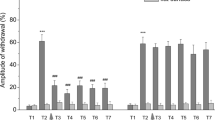Abstract
Experiments on common snails showed that three exposures to sensitizing stimuli (10% quinine applied to the snail's head every 15 min) induced synaptic facilitation in defensive behavior command neurons LPl1 and RPl1, with facilitation of responses to sensory stimuli lasting more than 24 h. Application of single stimuli produced transient synaptic facilitation and was expressed in responses to tactile stimulation of the head for about 1 h and in responses to dilute quinine for 3 h. Serotonin and cAMP imitated stimulus-specific transient synaptic facilitation. These substances facilitated the responses of neurons LPl1 and RPl1 to test stimulation of the head without producing changes in the responses to stimulation of other areas of skin on the animal's body. Calmodulin antagonists and glutamate NMDA receptor antagonists inhibited sensitization-induced synaptic facilitation in command neurons. Expression of transient synaptic facilitation depended on protein synthesis—it was suppressed by anisomycin and cycloheximide. It is suggested that transient synaptic facilitation during the acquisition of sensitization is associated with activation of translation/transcription processes and subsequent synthesis of specific short-lived protein molecules with selectively regulate the synaptic “inputs” of command neurons LPl1 and RPl1 from their specific skin innervation zones on the snail's head.
Similar content being viewed by others
References
V. D. Goncharuk, S. A. Kozyrev, and V. P. Nikitin, “Acquisition of sensitization in the common snail: morphofunctional correlates in defensive behavior command neurons,”Neirofiziologiya,1, No. 2, 150–157 (1993).
O. A. Kaksimova and P. M. Balaban,Neuronal Mechanisms of Behavioral Plasticity [in Russian], Nauka, Moscow (1983).
V. P. Nikitin and S. A. Kozyrev, “Dynamics of defensive and food-related responses during the acquisition of sensitization in the common snail,”Zh. Vyssh. Nerv. Deyat,41, No. 3, 478–489 (1991).
V. P. Nikitin and S. A. Kozyrev, “The effects of protein synthesis inhibitors on the neuronal mechanisms of sensitization in the common snail,”Neirofiziologiya,25, No. 2, 109–115 (1993).
V. P. Nikitin and S. A. Kozyrev, “Long-term synaptic facilitation during learning in snails: possible mechanisms for the formation of long-term memory,”Neirofiziologiya,25, No. 5, 383–389 (1993).
V. P. Nikitin and S. A. Kozyrev, “Generalized and signal-specific long-term nociceptive sensitization in the common snail,”Zh. Vyssh. Nerv. Deyat.,45, No. 4, 732–741 (1995).
V. P. Nikitin and S. A. Kozyrev, “Neuronal mechanisms of site-specific sensitization in the common snail,”Zh. Vyssh. Nerv. Deyat.,47, No. 6, 994–1003 (1997).
V. P. Nikitin, M. O. Samoilov, and S. A. Kozyrev, “Mechanisms of the acquisition of sensitization in the common snail: the involvement of calcium and calmodulin,”Zh. Vyssh. Nerv. Deyat.,42, No. 6, 1250–1259 (1992).
V. P. Nikitin and K. V. Sudakov, “Mechanism of the integrative activity of neurons,”Uspekhi Fiziol. Nauk.,28, No. 1, 27–46 (1997).
A. V. Shevelkin V. P., Nikitin, S. A. Kozyrev, M. O. Samoilov, and V. V. Sherstnev, “Serotonin imitates several of the neuronal effects of nociceptive sensitization in the common snail,”Zh. Vyssh. Nerv. Deyat.,47, No. 3, 532–542 (1997).
C. M. Alberini, M. Ghirardi, R. Metz and E. R. Kandel, “C/EBP is an immediate-early gene required for the consolidation of long-term facilitation inAplysia,”Cell,76, No. 6, 1099–1114 (1994).
C. H. Bailey, D. Bartsch, and E. R. Kandel, “Toward a molecular definition of long-term memory storage,”Proc. Natl. Acad. Sci. USA,24, No. 93, 13445–13452 (1996).
H. P. Davis and L. R. Squire, “Protein synthesis and memory. A review,”Psychol. Bull.,96, No. 3, 518–559 (1984).
M. Ghirardi, P. G. Montarolo, and E. R. Kandel, “A novel intermediate stage in the transition between short- and long-term facilitation in the sensory to motor neuron synapse ofAplysia,”Neuron,14, No. 2, 413–420 (1995).
S. A. Kozyrev, V. P. Nikitin, and A. V. Shevelkin, “Selective involvement of NMDA glutamate receptors in synapse-specific mechanisms of nociceptive sensitization in the snailHelix lucorum,” Abstr. Eur. Conf. “Simple Nervous Systems,” Moscow (1997).
G. G. Murphy and D. L. Glanzman, “Mediation of classical conditioning inAplysia californica by long-term potentiation of sensorimotor synapses,”Science,278, No. 5337, 467–471 (1997).
Author information
Authors and Affiliations
Additional information
Translated from Rossiiskii Fiziologicheskii Zhurnal imeni I. M. Sechenova, Vol. 85, No. 1, pp. 36–47, January, 1999.
Rights and permissions
About this article
Cite this article
Nikitin, V.P. The transient stage of long-term synaptic facilitation in defensive behavior command neurons in sensitized snails. Neurosci Behav Physiol 30, 267–276 (2000). https://doi.org/10.1007/BF02471780
Received:
Revised:
Issue Date:
DOI: https://doi.org/10.1007/BF02471780



